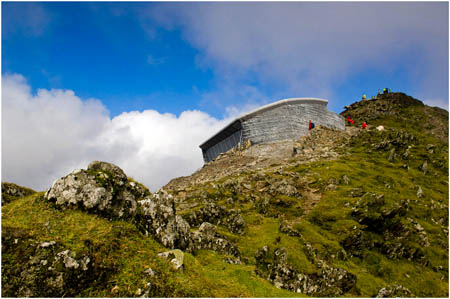
The defibrillator has been installed on the Hafod Eryri building on Snowdon. Photo: Aneurin Phillips
A lifesaving defibrillator has been installed at the top of Wales’s highest mountain.
The machine, which can be used on walkers suffering a heart attack, is now in place on the Hafod Eryri building at the summit of Snowdon.
The equipment is meant for members of the public who have training in its use, but with increased numbers of first-aiders being instructed in defibrillator use, it is hoped that the machine could save a life. Staff from the Snowdon Mountain Railway who work in the mountain-top cafe have been trained in its use. The project is a joint venture between the railway, Snowdonia National Park Authority, the Welsh Ambulance Service Trust, Arrhythmia Alliance and AED Locator.
Members of the Llanberis Mountain Rescue Team and national park wardens have also been trained to use the equipment.
There are currently 34 Public Access Defibrillator Schemes across Wales.
The automatic defibrillator works by applying an electric shock to casualties who are having a heart attack and works by either restarting the heart or regularising the chaotic beating that occurs during some attacks.
The equipment is housed in a green box on the outside of the building near the main entrance and can be accessed by phoning a number on the box for a code to allow its use. Emergency services advise that, even with a defibrillator available, it is important medical help is obtained by dialling 999 as soon as possible and calling out mountain rescuers via the police.
Rescue teams will need to know the location, how many people are involved, a description of the problem, weather conditions and the colour of clothing of those involved.
National PADS Manager Gerard Rothwell, based at Lansdowne Hospital, Cardiff, trained some of the Snowdon Mountain Railway cafe staff, Snowdonia National Park Authority wardens and Llanberis Mountain Rescue Team volunteers to be able to use the new summit equipment if the need arises.
Mr Rothwell said: “We carried out the training course at the summit building to give some of the staff skills in basic life support, recovery position and use of an automated external defibrillator, with practical scenarios.
“The summit is such an ideal place to have a PADS site due to the massive amount of people who visit it each year. Early response times to cardiac emergencies and the delivery of basic life-saving treatment are the key to saving lives.”
Six people died on Snowdon last year as a result of heart attacks.